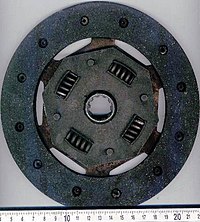
Photo from wikipedia
It is seen that the relative motion between the friction and separate plates causes drag torque of the disengaged wet clutch, which reduces the efficiency of the automatic transmission. A… Click to show full abstract
It is seen that the relative motion between the friction and separate plates causes drag torque of the disengaged wet clutch, which reduces the efficiency of the automatic transmission. A mathematical model of the drag torque was presented in this paper to study the effects of the grooves and waviness on the friction plate during the disengagement of the wet clutch. The modified Reynolds equation of the lubricant film was derived from the governing equations by considering the centrifugal effect. The finite difference method was applied to solve Reynolds equation, and the shape and size of groove and waviness on the friction plates were described by the thickness of lubricant film at each mesh point in the numerical solution. Equivalent outer radius was introduced to estimate the drag torque of the disengaged wet clutch based on Newton's internal friction theorem. The influencing factors including groove shapes, groove depth and width, waviness, lubricant viscosity, and supply flow were discussed to analyze their effects on the drag torque of the disengaged wet clutch. An experimental rig was set up to test the drag torque of the grooved wet clutch and results indicated that the theoretical drag torque had good agreement with the experimental data.
Journal Title: Proceedings of the Institution of Mechanical Engineers, Part J: Journal of Engineering Tribology
Year Published: 2018
Link to full text (if available)
Share on Social Media: Sign Up to like & get
recommendations!